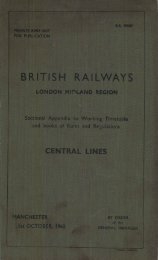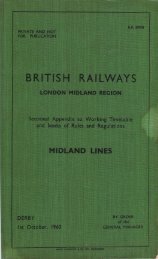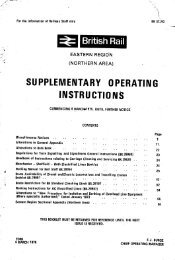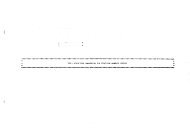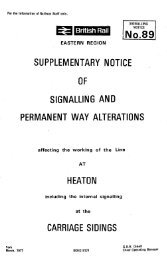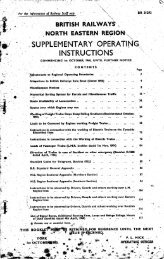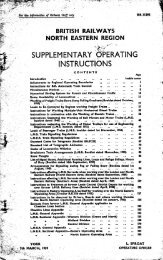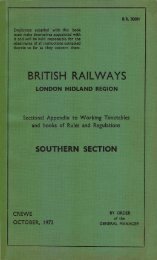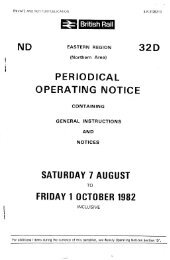- Page 3 and 4: CONTENTS OF VOL. Regulations for wo
- Page 5 and 6: Regulations for Working Single Line
- Page 7 and 8: Train Staff and Ticket System—Con
- Page 9 and 10: Train Staff and Ticket System—Con
- Page 11 and 12: REGULATIONS FOR WORKING SINGLE LINE
- Page 13 and 14: Regulations for Working Single Line
- Page 15 and 16: Lines worked by Electric Bells and
- Page 17 and 18: Regulations for Working Goods Lines
- Page 19 and 20: lExtracts from Block Telegraph Regu
- Page 21 and 22: Extracts from Block Telegraph Regul
- Page 23 and 24: Extracts from Block Telegraph Regul
- Page 25 and 26: 'Extracd from Block Telegraph Regul
- Page 27 and 28: N.E. Company's Exceptions to the R.
- Page 29 and 30: GENERAL INSTRUCTIONS. MOVEMENT OF L
- Page 31 and 32: General Instructions.—Continued.
- Page 33 and 34: General Instructions.—Continued.
- Page 35 and 36: Geneva! Instructions.—Continued.
- Page 37 and 38: General Irstructions.—Continued.
- Page 39 and 40: Signals fired near to one lacx id w
- Page 41: Signals fixed near to one box and w
- Page 45 and 46: General instructions.—Continued.
- Page 47 and 48: Morpeth ,1 12 STATION. Pegswood Che
- Page 49 and 50: 3/ ,Pelton • ,, • Telaw 2) STAT
- Page 51 and 52: Rillington York Barton Hill Ganton
- Page 53 and 54: Barlow Airmyn & Rawcliffe Goole &sa
- Page 55 and 56: Detenton at Home and Starting Signa
- Page 57 and 58: General Instructions.—Continued.
- Page 59 and 60: General Instructions.--Continued. 5
- Page 61 and 62: General Instructions.—Continued.
- Page 63 and 64: General Instructions.—Continued.
- Page 65 and 66: STATION. HAVERTON HILL HAYD ON BRID
- Page 67 and 68: STATION. WASE INGTON Y RE— tatio
- Page 69 and 70: General Instructions.—Continued.
- Page 71 and 72: General Instructions.—Continued.
- Page 73 and 74: General Instructions.—Continued.
- Page 75 and 76: General 1 nstructions.—Continued.
- Page 77 and 78: STATION. Malton to Marishes Road, i
- Page 79 and 80: General Enstructions.—Continued.
- Page 81 and 82: General nstructions.—Continued. 7
- Page 83 and 84: Genera! Nstrintins.---Continued. 8
- Page 85 and 86: General Instructions.—Continued.
- Page 87 and 88: General Instructions. Continued. 8
- Page 89 and 90: • General I nstructions•—Cont
- Page 91 and 92: Genera! instructions. 7 -Contin Len
- Page 93 and 94:
Genera i instructions.—Continued.
- Page 95 and 96:
Headlights of AutoLar Trains. Gener
- Page 97 and 98:
Genera! instructions.—Continved D
- Page 99 and 100:
7.—Middlesbrough Goods Yard. 1.
- Page 101 and 102:
General Instructions.—Continued.
- Page 103 and 104:
Generni instructions.—Continued.
- Page 105 and 106:
General Instructions.—Continued.
- Page 107 and 108:
List of Places where a Special Limi
- Page 109 and 110:
NAME OF BRANCH AND LOCALITY. Scotsw
- Page 111 and 112:
Lirnit2tion of Speed to be observed
- Page 113 and 114:
Restriction c4 Eng]nes over ceKain
- Page 115 and 116:
- General Instructions.—Continued
- Page 117 and 118:
From. Alnmouth North • • Whitti
- Page 119 and 120:
From. Loftus Station • Port Clare
- Page 121 and 122:
Trains drawn by Pilot Engines with
- Page 123 and 124:
Where Trains MUST NOT be coupled te
- Page 125 and 126:
General Instrisctions.—Continued.
- Page 127 and 128:
Cermrai Enstrintions.—Continued.
- Page 129 and 130:
General Onstructions.—Continued.
- Page 131 and 132:
From a horizontal position, thus Ho
- Page 133 and 134:
General Instructions.—Continued.
- Page 135 and 136:
SECTION, General instructions.—Co
- Page 137 and 138:
Vehicles attached to rear of Passen
- Page 139 and 140:
Vehicles attached to rear el Passen
- Page 141 and 142:
Vehicles attached to rear of Passen
- Page 143 and 144:
General instructions.—Continued.
- Page 145 and 146:
Vices attached to rear of Passenger
- Page 147 and 148:
— . MAXIMUM AVERAGE SPEED EN' M.P
- Page 149 and 150:
General Instructions.—Continued.
- Page 151 and 152:
General Instructions.—Continued.
- Page 153 and 154:
General !nstructions.—Continued.
- Page 155 and 156:
GUARDS OF PASSENGER TRAINS KEERING
- Page 157 and 158:
)2 General rnstructions.---Continue
- Page 159 and 160:
General Instrections—Continued.
- Page 161 and 162:
General instructions.—Continued.
- Page 163 and 164:
General nstructions.—Continued. 1
- Page 165 and 166:
Propelling of Stores Vans. General
- Page 167 and 168:
STATION. Pickering Port Clarence Re
- Page 169 and 170:
List of Places where special author
- Page 171 and 172:
General instructions.—(Continued)
- Page 173 and 174:
General instructiers.—Continued.
- Page 175 and 176:
Average M.P.H. Not to exceed Genera
- Page 177 and 178:
Genera! instructions•—Continued
- Page 179 and 180:
Genera! instructions.—Continued.
- Page 181 and 182:
General Instructions.—Continued.
- Page 183 and 184:
Line. General instructions.—Conti
- Page 185 and 186:
General instructions.—Continued.
- Page 187 and 188:
General Instructions,—(Continued)
- Page 189 and 190:
General Instructions. - Platelayers
- Page 191 and 192:
Special Instructions applicable at
- Page 193 and 194:
Special Instructions applicable at
- Page 195 and 196:
Special Instructions applicable at
- Page 197 and 198:
Special Instructions applicable at
- Page 199 and 200:
Special Instructions applicable at
- Page 201 and 202:
Special Instructians applicable at
- Page 203 and 204:
Special Instructions applicable at
- Page 205 and 206:
Special Instructions applicable at
- Page 207 and 208:
Special Instructions applicable at
- Page 209 and 210:
4 I : T h . e p l a o s o s p e l n
- Page 211 and 212:
Special Instructions applicable at
- Page 213 and 214:
Special Instructions applicable at
- Page 215 and 216:
Special Instructions applicable at
- Page 217 and 218:
Special Instructions applicable at
- Page 219 and 220:
Special Instructions applicable at
- Page 221 and 222:
Special Instructions applicable at
- Page 223 and 224:
Special Instructions applicable at
- Page 225 and 226:
Special Instructions applicable at
- Page 227 and 228:
Special Instructions applicable at
- Page 229 and 230:
STATION. Thirsk 'Croft Spa Darlingt
- Page 231 and 232:
STATION. Fencehouses Pelaw. P3 Fell
- Page 233 and 234:
Sections of Line worked by Recordin
- Page 235 and 236:
Hull—con. Malton STATION. Hull Ea
- Page 237 and 238:
Terminal Stations.—Continued. STA
- Page 239 and 240:
(3) 'Where the Block Telegraph Regu
- Page 241 and 242:
Where Modified Block Telegraph Regu
- Page 243 and 244:
List of iock Sections where the Hom
- Page 245 and 246:
243 List of Block Sections which ar
- Page 247 and 248:
Sections which deal with Passenger
- Page 249 and 250:
Sections which deal with Passenger
- Page 251 and 252:
249 Sections where Fe trains ;rust
- Page 253 and 254:
Sections where NO trains must be de
- Page 255 and 256:
Durham Eaglescliffe STATION. Etherl
- Page 257 and 258:
STATION. Monkseaton Monkseaton Newc
- Page 259 and 260:
Staff or Tablet Stations, Sections,
- Page 261 and 262:
STAPP OR TABLET STATIONS AND SECTIO
- Page 263 and 264:
STAFF OR TABLET STATIONS AND SECTIO
- Page 265 and 266:
1 IIIMIS MIMME hmonatilM• tragE t
- Page 267 and 268:
CANIMEMOCISMEEMSEULISMVZIEMINV STAF
- Page 269 and 270:
mooxoemzolimmzEtsvatworalotar.rwArn
- Page 271 and 272:
STAFF OR TABLET STATIONS AND SECTIO
- Page 273 and 274:
- START OR TABLET STATION S AN D SE
- Page 275 and 276:
STAFF OR TABLET STATIONS AND SECTIO
- Page 277 and 278:
STAFF OR TABLET STATIONS AND SECTIO
- Page 279 and 280:
Single Li nes.—Continued. 2 7 7 H
- Page 281 and 282:
The guard of a disabled train or th
- Page 283 and 284:
LINE. Lingdale Branch Junction to L
- Page 285 and 286:
Single Lines.—Continued. 2 8 3 Ad
- Page 287 and 288:
Single Li nes.—Continued. 2 8 5 C
- Page 289 and 290:
Single Lines.—Continued. 2 8 7 GA
- Page 291 and 292:
Single Lines.—Continued. 2 8 9 Pa
- Page 293 and 294:
Single Lines.—Continued. 2 9 1 TE
- Page 295 and 296:
Single Lines.—Continued. 2 9 3 Li
- Page 297 and 298:
A- ccidents, Appliances on trains A
- Page 299 and 300:
Diversion of Main Line Trains in Ac
- Page 301 and 302:
PAGES. Headlights, special and exce
- Page 303 and 304:
Pilotman, Double Line working after
- Page 305:
V. Vacuum brake, Companies using Va




